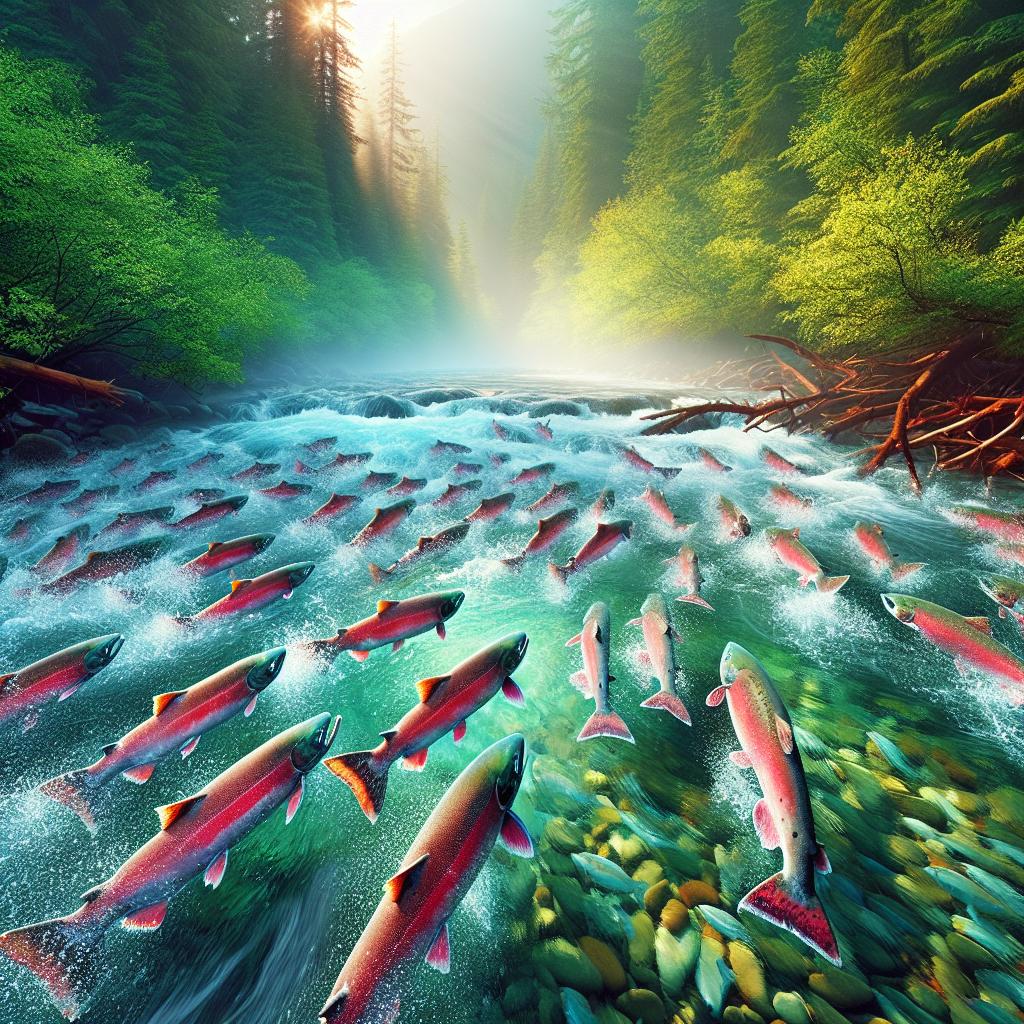

Salmon returning to river.
In Siskiyou County, California, significant work is underway to restore the Klamath River ecosystem as we approach the completion of the largest dam removal project in U.S. history. Crews have been busy using excavators to breach rock dams, allowing the river to flow freely into its historic channel, which marks the first time in more than a century that salmon will have unimpeded access to the river and its tributaries.
The Klamath River is crucial for salmon populations, especially during the fall spawning season. As the work progresses, it is expected that spawning Chinook salmon, also known as king salmon, will be able to access vital habitats that have been cut off for decades. Leaf Hillman, a ceremonial leader of the Karuk Tribe, expressed his optimism, saying, “Seeing the river being restored to its original channel and that dam gone, it’s a good omen for our future.” Salmon are not just a resource; they hold deep cultural and spiritual significance for many tribes in the region.
Removing the Klamath River dams is part of a greater trend across the country aimed at restoring rivers to their natural flows and ecosystems for both fish and wildlife. Since February of this year, over 2,000 dams have been removed in the U.S., with many of those actions occurring within the last 25 years. Successful removals have taken place on numerous rivers, including Washington state’s Elwha River.
Environmentalists and tribal leaders are optimistic about the future of the Klamath River’s ecosystem. Joshua Chenoweth, a senior riparian ecologist for the Yurok Tribe, stated, “Now the healing can really begin as far as the river restoring itself.” This sentiment is echoed by many who believe that nature can rebound once the barriers to its flow are removed.
The Klamath River was once celebrated as the third-largest salmon-producing river on the West Coast. However, that changed dramatically when power company PacifiCorp constructed dams between 1918 and 1962. These dams drastically interrupted the salmon’s natural lifecycle, leading to a severe decline in their population. A particularly disastrous incident occurred in 2002 when warm temperatures and low water levels triggered a bacterial outbreak, killing over 34,000 fish, mainly Chinook salmon. This catastrophe ignited persistent efforts by tribes and environmental groups to remove the dams, efforts that finally bore fruit with the federal approval of the removal plan in 2022.
As of now, **Copco No. 2** has already been removed, and removal of the larger dams like Iron Gate and Copco No. 1 is set to be completed soon. Reports indicate that these demolitions should not significantly impact the power supply; at their peak, these dams produced less than 2% of PacifiCorp’s energy—enough to power around 70,000 homes.
While the anticipated restoration of salmon habitats is encouraging, it’s still uncertain how long it will take for fish populations to rebound. Michael Belchik, a senior water policy analyst for the Yurok Tribe, expressed optimism over seeing salmon navigate past the dams soon, stating, “I think we’re going to have some early successes. I’m pretty confident we’ll see some fish going above the dam. If not this year, then for sure next year.”
There are still two other smaller dams located upstream, but these features allow salmon to pass via fish ladders, a structure designed to help fish navigate around barriers. Mark Bransom, chief executive of the Klamath River Renewal Corporation, the organization overseeing the project, cautioned, “I don’t know if anybody knows with any certainty what it means for the return of fish. It’ll take some time. You can’t undo 100 years’ worth of damage and impacts to a river system overnight.”
In summary, the removal of these dams is a momentous step towards ecological restoration in the Klamath River Basin. Tribal leaders, environmentalists, and community members eagerly await the results as they work towards a sustainable future for salmon populations and their habitats.
News Summary The Trump administration has acknowledged a significant mistake in deporting Kilmar Abrego Garcia,…
News Summary Tensions rise as Iran raises concerns with the UN after President Trump's threatening…
News Summary Recent military exercises conducted by China's armed forces near Taiwan have escalated tensions…
News Summary A federal judge has ruled that Alabama cannot prosecute doctors or reproductive health…
News Summary The Chinese military has launched significant military drills around Taiwan, aimed at sending…
News Summary The special election for Florida's 6th District is heating up as Democratic candidate…